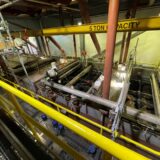A Complete Guide to Preventive Maintenance Inspections for the Industrial Sector
Introduction to Preventive Maintenance in the Industrial Sector
Preventive maintenance in the industrial sector is all about staying ahead. Think of it as your machinery’s health plan. Just like you wouldn’t wait until you’re really sick to see a doctor, you shouldn’t wait for your equipment to break down to start caring for it. By scheduling regular check-ups, you keep everything running smoothly and avoid the big headaches of unplanned downtime. In essence, preventive maintenance involves inspecting, servicing, and maintaining your equipment regularly to keep it running in top-notch condition. This routine care can catch small issues before they become big problems, saving you time, money, and stress. It’s about being proactive, not reactive.
The Importance of Preventive Maintenance Inspections
Preventive maintenance inspections are like your regular health check-up but for machines. These checks stop problems before they start, saving you time, money, and stress. Imagine a machine breaking down unexpectedly. Work stops, deadlines are missed, and repair costs soar. Regular inspections keep machines running smoothly and workers safe. They also extend the life of your equipment, making sure you get the most out of your investment. Think about it: a small effort now can prevent a major headache later. It’s about staying ahead, not just keeping up.
Identifying the Types of Preventive Maintenance
In the realm of the industrial sector, preventive maintenance takes center stage in avoiding unscheduled downtimes and ensuring machinery runs smoothly. Breaking it down, there are mainly three types of preventive maintenance: time-based, usage-based, and predictive maintenance. Let’s dive into each one without any fluff.
Time-based maintenance happens on a schedule. Think of it like giving your car an oil change every 5,000 kms, but for industrial machinery. Whether it’s every 30 days or once a year, this approach relies on the calendar to prevent failures before they occur.
Next up, usage-based maintenance. This type is all about how much a machine has been used. For example, replacing parts after a certain number of hours of operation. It’s like changing your tires after 70,000 kms, no matter how many months or years it takes to hit that mark.
Lastly, we have predictive maintenance, which is a bit more tech-savvy. This method uses real-time data from equipment to predict when maintenance should happen. It’s like a smartwatch that alerts you about your heart health, but for machines, indicating when something might go wrong before it actually does.
So, there you have it. Different machines and situations call for different approaches. Knowing which type of preventive maintenance to apply and when can save a lot of time, money, and headaches down the road. It’s all about staying one step ahead.
Planning Your Preventive Maintenance Schedule
To keep your machines running smoothly and prevent costly breakdowns, planning your preventive maintenance schedule is key. Here’s the deal: you want to check your machinery regularly, but not too often you waste time and resources. Strike a balance. Start by identifying critical equipment, the ones that if they stop, everything stops. Next up, understand the manufacturer’s recommended service intervals for each piece of equipment. That’s your starting point.
Now, think about how much you use your equipment. More use might mean more frequent checks. But, let’s keep it simple. Break your schedule into daily, weekly, monthly, and yearly tasks. For daily checks, focus on basics like leaks, noises, or anything that looks off. Weekly, you might check lubrication and tighten loose bolts. Monthly and yearly tasks can include more in-depth checks and replacements.
Remember, flexibility is your friend. Adjust the schedule as you learn more about how your equipment operates under your specific conditions. Keep records of everything: what you checked, what you found, and what you fixed. These records are gold for making smart decisions later on.
In short, plan smart, check regularly, adjust as needed, and record everything. That’s how you keep your operations smooth and avoid those gut-wrenching breakdowns.
Key Components of a Preventive Maintenance Inspection
When we talk about preventive maintenance inspections in the industrial sector, a few crucial components come to mind. First, visual inspections are the backbone. This means checking machinery and equipment for any obvious signs of wear or damage. It’s about looking at things closely, really seeing if anything seems off. Next up, we’ve got lubrication. It’s simple but vital. Machines need to stay slick to run smoothly. Too little or too much, and you’re asking for trouble. Then, there’s cleaning. Dirt, dust, and grime aren’t just messy; they can seriously mess up your equipment. Keeping things clean is keeping things running. Don’t forget about testing and measurement. This involves running tests and using tools to measure performance. Think of it as a health check-up for machines. Last but not least, record keeping. This might sound boring but hear me out. Keeping good records means you know what’s been done, what needs doing, and when. It’s your map in the world of maintenance. So, that’s the gist. Keep your eyes open, everything lubed, clean, checked, and recorded. Stick to this, and you’re setting yourself up for success.
Tools and Technologies for Effective Preventive Maintenance
In the world of maintenance, especially in the industrial sector, having the right tools and technologies is a game-changer. For preventive maintenance to be truly effective, you need more than just a wrench and a checklist. Today, there are advanced tools and technology solutions engineered to keep machinery running smoothly and reduce downtime.
First off, we have Computerized Maintenance Management Systems (CMMS). These systems are the backbone of any preventive maintenance program. They allow you to schedule inspections, track maintenance tasks, and keep a detailed history of all maintenance activities. It’s like having a digital brain for your maintenance operations.
Then, there’s the Internet of Things (IoT). IoT devices can be attached to your equipment, constantly monitoring their performance and sending data in real-time. This means you can catch issues before they escalate into bigger problems. Imagine getting an alert on your phone when a machine starts acting up – that’s IoT in action.
Another critical technology is predictive maintenance software. This software analyzes data from your machinery to predict future failures. It takes preventive maintenance one step further by not just preventing known issues but by foreseeing potential ones.
And let’s not forget about drones and robots. These are not just cool gadgets; they can perform inspections in areas that are hazardous or hard to reach for humans. They can go into tight spaces or handle extreme temperatures, making them perfect for industrial environments.
Lastly, mobile apps have also become an essential tool. They allow maintenance teams to access information and input data directly from the field, streamlining the process and ensuring real-time updates.
In sum, to elevate your preventive maintenance, diving into these technologies is not just beneficial; it’s necessary. They save time, reduce costs, and, most importantly, they keep your operations running without a hitch.
Training Your Team for Preventive Maintenance Success
To get the best out of preventive maintenance, your team needs to be sharp. This isn’t just about knowing what to do; it’s about doing it consistently and effectively. First, ensure everyone understands the basics of your machinery. They don’t need to be engineers, but a solid grasp of what makes the machines tick is essential. Next, invest in training. This could be internal workshops led by experienced team members or professional courses. Regular updates as technology and techniques evolve are crucial too. Remember, the right attitude matters as much as technical skills. Encourage a culture where maintenance is seen as everyone’s responsibility, not just another task on the to-do list. Keep it practical, keep it regular, and watch your preventive maintenance program transform from a chore into a well-oiled machine, pun intended.
Common Challenges in Preventive Maintenance and How to Overcome Them
In the industrial sector, preventive maintenance is key to keeping operations smooth and preventing costly downtime. Yet, challenges pop up, making it tough sometimes. Let’s dive into these common hurdles and how to leap over them. First, timing can be tricky. You’ve got to inspect equipment regularly without disrupting the workflow. The trick? Schedule maintenance during off-peak hours or when the machine is not in use. It’s all about finding that sweet spot. Second, there’s the cost. Yes, maintenance isn’t cheap, but think of it as avoiding a bigger bill down the line. To manage costs, prioritize tasks based on the equipment’s importance and failure risk. This way, you’re always keeping your eye on the prize—operational efficiency without breaking the bank. Lastly, sometimes there’s resistance to change. People get set in their ways, or there’s a lack of skills. Overcome this by training your team. Make sure they know not just the how, but the why behind preventive maintenance. And hey, involve them in the planning process; it’s a game-changer for buy-in. So, face these challenges head-on, and your preventive maintenance won’t just be routine, it’ll be a strategic asset.
Case Studies: Successful Preventive Maintenance Practices
In the industrial sector, adopting preventive maintenance practices isn’t just a choice—it’s a necessity for operational excellence. Let’s look at some real-life cases that prove just how transformative these practices can be. First up, we have a manufacturing plant that transitioned from reactive to preventive maintenance. This switch led to a whopping 30% reduction in machine downtime within the first year alone. How? By scheduling regular inspections, the plant could identify and resolve issues before they escalated into costly breakdowns. Another case involves a food processing company. Here, the implementation of a rigorous preventive maintenance program resulted in a 50% decrease in unplanned maintenance activities. The company achieved this by using predictive maintenance technologies, allowing them to foresee potential equipment failures and act swiftly. Lastly, let’s not forget about the energy sector. A power plant reported an impressive 25% increase in equipment life expectancy post the adoption of preventive maintenance strategies. This was primarily due to the meticulous tracking of equipment performance and the timely replacement of parts before they failed. These examples clearly illustrate the significant benefits of maintaining a strong preventive maintenance routine. Improved efficiency, reduced downtime, and extended equipment lifespan are just the tip of the iceberg.
Conclusion: Next Steps for Implementing Preventive Maintenance Inspections
So, you’ve got all the facts on preventive maintenance inspections. What’s next? Start simple. First, evaluate your current maintenance procedures. Are they working? Where are gaps? Next, prioritize creating or updating your preventive maintenance plan based on the equipment critical to your operations. Focus on machines that, if they failed, would throw a wrench in your productivity. Don’t forget to involve your team. Their firsthand experience with the machinery can provide valuable insights into what needs the most attention and when. Finally, kick things into gear. Implement the plan, track results, and adjust as needed. Remember, the goal is to prevent problems before they start, saving you time and money in the long run. Keep it straightforward, and don’t let perfection be the enemy of good. Start today, and improve as you go.



